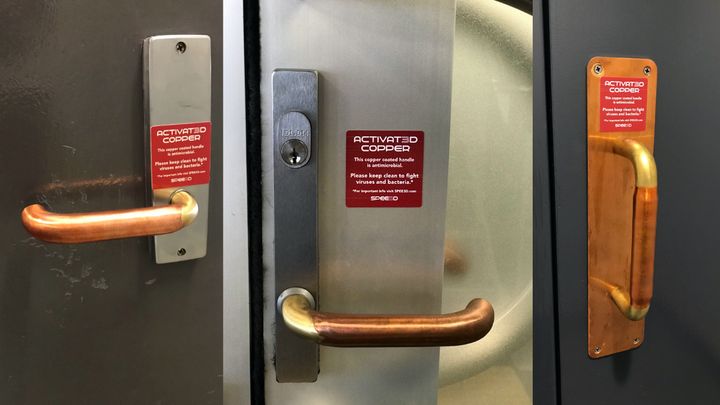
A validated COVID-19 utility solution announced by SPEE3D has now been adopted by a government agency.
SPEE3D is an Australian company that markets a very unique 3D printer. Their device literally uses supersonic particles to quickly 3D print metal objects. The process uses the kinetic energy of fast moving particles to instantaneously fuse upon impact. By gradually moving the deposition tool, they are able to create metal objects quickly and efficiently.
Their speedy process (hence their company name) is far faster than typical powder bed fusion approaches. In fact at last year’s Formnext exhibition they performed a live 3D printing demonstration in which they were able to 3D print an entire copper hammer in only 10 minutes!
One of the interesting properties of their unique 3D printing process is the ability to “coat” existing objects. Normally their process simply starts with a bare build platform and “grows” an object by repeated and continuous depositions. However, it’s also possible to insert an existing object into their build platform and have the deposition take place on the object’s surface. This is quite useful for providing a new layer of material on top of an existing object.
Copper and COVID-19
Copper is well-known as an antibacterial agent, and is often used to destroy bacteria. Can this also work on viruses, such as the now-infamous COVID-19 bug?
It’s a little tricky, because viruses are not technically “alive”, and thus cannot be “killed”. A virus works by simply inserting its DNA into a nearby living cell to force the cell to reproduce more viruses. It’s a mechanical, rather than a living, process.
Research on the COVID-19 virus has shown that it unfortunately can survive for lengthy periods on a surface. The duration varies by the conditions of the environment and the type of surface material involved. For fabric or wood materials, the “survival” time is relatively short, but for metals and plastic it is much longer, even days.
I should say that “survive” is probably not the best word to describe the virus, as it isn’t alive as I explained above. Instead it might be “deactivated” or otherwise rendered non-functional in that it is unable to inject its DNA payload into living cells that come near it.
Research has previously shown that copper has a good chance of breaking down the virus material faster than many other common metals.
Keeping Surfaces Clean of Viruses
Regardless, if the virus is functional and on a surface there is a possibility someone could touch the surface and pick up the virus. From the hands it’s only a short gesture away to touch one’s nose, eyes or mouth, giving the virus a chance to act.
This is why everyone is disinfecting surfaces that are frequently touched: they may hold virus deposits. Unfortunately there are plenty of things we must touch in daily life that cannot be avoided.
An interesting idea was brought forward by SPEE3D, who realized they could use their copper 3D printing capability to coat common objects relatively quickly. This might be able to help slow the progress of the virus by rendering it harmless, if it could be deactivated as previous experiments with copper metal had shown.
As we noted in our previous story on SPEE3D’s copper solution, they have obtained that proof, as 360Biolabs, a lab accredited by the Australian NATA (National Association of Testing Authorities) has certified the results of the copper deposition. They say:
“The Australian NATA accredited clinical trial speciality laboratory, 360Biolabs, tested the effect of ACTIVAT3D copper on live SARS-CoV-2 and results showed that 96% of the virus is killed in two hours and 99.2% of the virus is killed in 5 hours. Stainless steel showed no reduction in the same time frame. “
SPEED3D was able to design a 3D printing deposition process to coat typical door handles in copper in only five minutes, with a copper process they call “ACTIVAT3D”. This new product has been adopted by the Australian Northern Territory Department of Trade, Business and Innovation to replace the door handles of their premises. The images at top show how the door handles appear as deployed.
Is this a workable solution? I think it could be. Consider that everywhere else businesses have instituted policies to repeatedly disinfect touched surfaces. For example, at the grocery store you may find someone wiping down the cart or basket before they hand it to you. Similarly, businesses may have someone disinfecting door handles periodically throughout the day. Perhaps every two hours.
A copper door handle could simplify that process. While it doesn’t protect you from picking up germs from the infected person who used the door handle five minutes earlier, neither does a two-hour wipe down. In an operation involving many door handles this could be a significant time saver, and one that definitely reduces viral spread.
It’s not clear how SPEE3D may scale up this process, as there are an awful lot of door handles in the world, but every step helps. SPEE3D says:
“The lab results have sparked global interest in this technology as Governments and private companies look for proactive ways to protect their communities. Whilst SPEE3D were able to pivot their business and rapidly go into production of antimicrobial copper door fixtures to meet this demand, their specialty is in the design and manufacture of metal 3D printing equipment and software. With this technology now proven and enquiries coming in from around the world, SPEE3D are looking to partner the door handle manufacturing industry to deliver ACTIVAT3D copper at scale to where it is needed most.”
It may be that in the future all door handles will be made of copper, but for now you’ll have to get yours coated by SPEE3D.
Via SPEE3D
